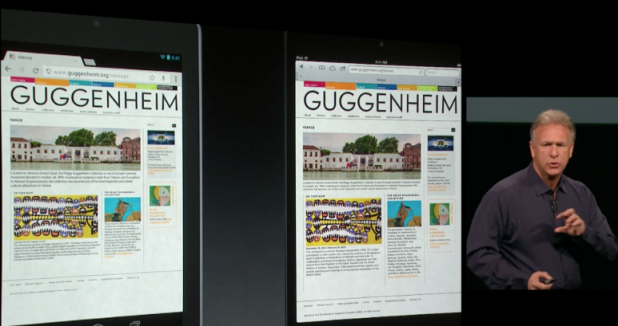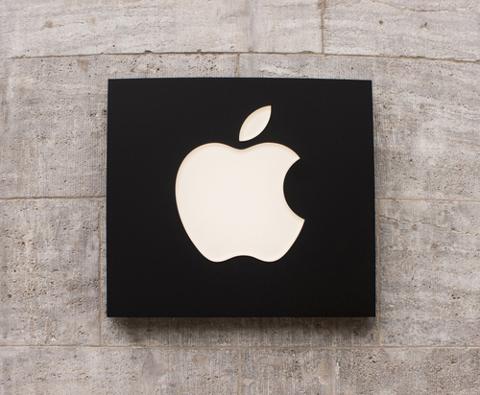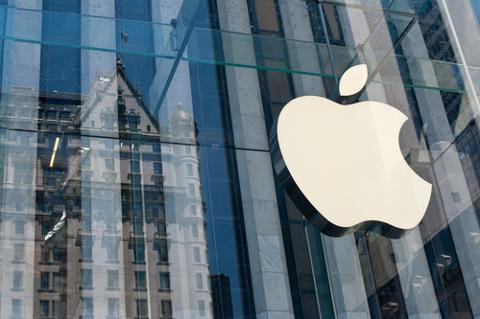 Apple used its Oct. 23 event to roll out new iPads and Macs. Here, marketing head Phil Schiller talks tablets.[/caption] Most of the tech punditry and media attending Apple’s Oct. 23 event expected the company to unveil a new, smaller iPad. Instead, Apple executives took the stage to roll out lots of new hardware: not only a new “iPad Mini,” but also a fourth-generation iPad, a new 13.3-inch MacBook Pro with a high-resolution Retina Display, a Mac Mini, and a thinner iMac. One can only conjecture whether Apple chose to engage in such a wide-ranging hardware refresh in order to blunt the rollout of Microsoft’s Windows 8, which made its official debut two days later in a high-profile New York City event. But given how Apple is a highly disciplined company run by executives who leave few things to chance, it’s safe to assume that the introduction of those new iPads and Macs was timed for maximum impact. The iPad faces many opponents this holiday season: Google’s Nexus 7 (augmented by whatever hardware the search-engine giant decides to debut early next week), Amazon’s revamped Kindle Fire, and Microsoft’s Surface, a Windows 8 tablet with a flexible keyboard that doubles as a cover. Surface is Microsoft’s flagship device for muscling its way into a mobile-device market currently dominated by Apple and Google; as such, it’s backed by an enormous retail footprint and advertising budget. While it doesn’t represent an existential threat to Apple, it’s also the harbinger of a much tougher fight for Cupertino in the quarters ahead. In an Oct. 25 earnings call, Apple CEO Tim Cook reserved a bit of time to hammer Surface as lacking in focus. “What we are reading about it is that it’s a fairly compromised confusing product,” he told those listening to the call, according to a transcript posted on Seeking Alpha. “I think one of the toughest things you do with deciding which product is to make hard trade-offs and decide what a product should be and we really done that with the iPad.” Cook added: “I supposed you could design a car that flies and floats, but I don’t think it would do all of those things every well.” That echoes his comments from earlier this year, when he told another earnings-call audience that Windows 8 was the operating system equivalent of trying to “converge a toaster and a refrigerator.” In order to work effectively on both tablets and PCs, Windows 8 marries two distinct user interfaces: a Start screen of colorful tiles linked to applications (the better to tap on a touch-screen device) and a more traditional desktop.
Apple used its Oct. 23 event to roll out new iPads and Macs. Here, marketing head Phil Schiller talks tablets.[/caption] Most of the tech punditry and media attending Apple’s Oct. 23 event expected the company to unveil a new, smaller iPad. Instead, Apple executives took the stage to roll out lots of new hardware: not only a new “iPad Mini,” but also a fourth-generation iPad, a new 13.3-inch MacBook Pro with a high-resolution Retina Display, a Mac Mini, and a thinner iMac. One can only conjecture whether Apple chose to engage in such a wide-ranging hardware refresh in order to blunt the rollout of Microsoft’s Windows 8, which made its official debut two days later in a high-profile New York City event. But given how Apple is a highly disciplined company run by executives who leave few things to chance, it’s safe to assume that the introduction of those new iPads and Macs was timed for maximum impact. The iPad faces many opponents this holiday season: Google’s Nexus 7 (augmented by whatever hardware the search-engine giant decides to debut early next week), Amazon’s revamped Kindle Fire, and Microsoft’s Surface, a Windows 8 tablet with a flexible keyboard that doubles as a cover. Surface is Microsoft’s flagship device for muscling its way into a mobile-device market currently dominated by Apple and Google; as such, it’s backed by an enormous retail footprint and advertising budget. While it doesn’t represent an existential threat to Apple, it’s also the harbinger of a much tougher fight for Cupertino in the quarters ahead. In an Oct. 25 earnings call, Apple CEO Tim Cook reserved a bit of time to hammer Surface as lacking in focus. “What we are reading about it is that it’s a fairly compromised confusing product,” he told those listening to the call, according to a transcript posted on Seeking Alpha. “I think one of the toughest things you do with deciding which product is to make hard trade-offs and decide what a product should be and we really done that with the iPad.” Cook added: “I supposed you could design a car that flies and floats, but I don’t think it would do all of those things every well.” That echoes his comments from earlier this year, when he told another earnings-call audience that Windows 8 was the operating system equivalent of trying to “converge a toaster and a refrigerator.” In order to work effectively on both tablets and PCs, Windows 8 marries two distinct user interfaces: a Start screen of colorful tiles linked to applications (the better to tap on a touch-screen device) and a more traditional desktop.
Apple CEO Cook Talks Surface, Cannibalization
[caption id="attachment_5486" align="alignleft" width="618"]  Apple used its Oct. 23 event to roll out new iPads and Macs. Here, marketing head Phil Schiller talks tablets.[/caption] Most of the tech punditry and media attending Apple’s Oct. 23 event expected the company to unveil a new, smaller iPad. Instead, Apple executives took the stage to roll out lots of new hardware: not only a new “iPad Mini,” but also a fourth-generation iPad, a new 13.3-inch MacBook Pro with a high-resolution Retina Display, a Mac Mini, and a thinner iMac. One can only conjecture whether Apple chose to engage in such a wide-ranging hardware refresh in order to blunt the rollout of Microsoft’s Windows 8, which made its official debut two days later in a high-profile New York City event. But given how Apple is a highly disciplined company run by executives who leave few things to chance, it’s safe to assume that the introduction of those new iPads and Macs was timed for maximum impact. The iPad faces many opponents this holiday season: Google’s Nexus 7 (augmented by whatever hardware the search-engine giant decides to debut early next week), Amazon’s revamped Kindle Fire, and Microsoft’s Surface, a Windows 8 tablet with a flexible keyboard that doubles as a cover. Surface is Microsoft’s flagship device for muscling its way into a mobile-device market currently dominated by Apple and Google; as such, it’s backed by an enormous retail footprint and advertising budget. While it doesn’t represent an existential threat to Apple, it’s also the harbinger of a much tougher fight for Cupertino in the quarters ahead. In an Oct. 25 earnings call, Apple CEO Tim Cook reserved a bit of time to hammer Surface as lacking in focus. “What we are reading about it is that it’s a fairly compromised confusing product,” he told those listening to the call, according to a transcript posted on Seeking Alpha. “I think one of the toughest things you do with deciding which product is to make hard trade-offs and decide what a product should be and we really done that with the iPad.” Cook added: “I supposed you could design a car that flies and floats, but I don’t think it would do all of those things every well.” That echoes his comments from earlier this year, when he told another earnings-call audience that Windows 8 was the operating system equivalent of trying to “converge a toaster and a refrigerator.” In order to work effectively on both tablets and PCs, Windows 8 marries two distinct user interfaces: a Start screen of colorful tiles linked to applications (the better to tap on a touch-screen device) and a more traditional desktop.
Apple used its Oct. 23 event to roll out new iPads and Macs. Here, marketing head Phil Schiller talks tablets.[/caption] Most of the tech punditry and media attending Apple’s Oct. 23 event expected the company to unveil a new, smaller iPad. Instead, Apple executives took the stage to roll out lots of new hardware: not only a new “iPad Mini,” but also a fourth-generation iPad, a new 13.3-inch MacBook Pro with a high-resolution Retina Display, a Mac Mini, and a thinner iMac. One can only conjecture whether Apple chose to engage in such a wide-ranging hardware refresh in order to blunt the rollout of Microsoft’s Windows 8, which made its official debut two days later in a high-profile New York City event. But given how Apple is a highly disciplined company run by executives who leave few things to chance, it’s safe to assume that the introduction of those new iPads and Macs was timed for maximum impact. The iPad faces many opponents this holiday season: Google’s Nexus 7 (augmented by whatever hardware the search-engine giant decides to debut early next week), Amazon’s revamped Kindle Fire, and Microsoft’s Surface, a Windows 8 tablet with a flexible keyboard that doubles as a cover. Surface is Microsoft’s flagship device for muscling its way into a mobile-device market currently dominated by Apple and Google; as such, it’s backed by an enormous retail footprint and advertising budget. While it doesn’t represent an existential threat to Apple, it’s also the harbinger of a much tougher fight for Cupertino in the quarters ahead. In an Oct. 25 earnings call, Apple CEO Tim Cook reserved a bit of time to hammer Surface as lacking in focus. “What we are reading about it is that it’s a fairly compromised confusing product,” he told those listening to the call, according to a transcript posted on Seeking Alpha. “I think one of the toughest things you do with deciding which product is to make hard trade-offs and decide what a product should be and we really done that with the iPad.” Cook added: “I supposed you could design a car that flies and floats, but I don’t think it would do all of those things every well.” That echoes his comments from earlier this year, when he told another earnings-call audience that Windows 8 was the operating system equivalent of trying to “converge a toaster and a refrigerator.” In order to work effectively on both tablets and PCs, Windows 8 marries two distinct user interfaces: a Start screen of colorful tiles linked to applications (the better to tap on a touch-screen device) and a more traditional desktop.
 Apple used its Oct. 23 event to roll out new iPads and Macs. Here, marketing head Phil Schiller talks tablets.[/caption] Most of the tech punditry and media attending Apple’s Oct. 23 event expected the company to unveil a new, smaller iPad. Instead, Apple executives took the stage to roll out lots of new hardware: not only a new “iPad Mini,” but also a fourth-generation iPad, a new 13.3-inch MacBook Pro with a high-resolution Retina Display, a Mac Mini, and a thinner iMac. One can only conjecture whether Apple chose to engage in such a wide-ranging hardware refresh in order to blunt the rollout of Microsoft’s Windows 8, which made its official debut two days later in a high-profile New York City event. But given how Apple is a highly disciplined company run by executives who leave few things to chance, it’s safe to assume that the introduction of those new iPads and Macs was timed for maximum impact. The iPad faces many opponents this holiday season: Google’s Nexus 7 (augmented by whatever hardware the search-engine giant decides to debut early next week), Amazon’s revamped Kindle Fire, and Microsoft’s Surface, a Windows 8 tablet with a flexible keyboard that doubles as a cover. Surface is Microsoft’s flagship device for muscling its way into a mobile-device market currently dominated by Apple and Google; as such, it’s backed by an enormous retail footprint and advertising budget. While it doesn’t represent an existential threat to Apple, it’s also the harbinger of a much tougher fight for Cupertino in the quarters ahead. In an Oct. 25 earnings call, Apple CEO Tim Cook reserved a bit of time to hammer Surface as lacking in focus. “What we are reading about it is that it’s a fairly compromised confusing product,” he told those listening to the call, according to a transcript posted on Seeking Alpha. “I think one of the toughest things you do with deciding which product is to make hard trade-offs and decide what a product should be and we really done that with the iPad.” Cook added: “I supposed you could design a car that flies and floats, but I don’t think it would do all of those things every well.” That echoes his comments from earlier this year, when he told another earnings-call audience that Windows 8 was the operating system equivalent of trying to “converge a toaster and a refrigerator.” In order to work effectively on both tablets and PCs, Windows 8 marries two distinct user interfaces: a Start screen of colorful tiles linked to applications (the better to tap on a touch-screen device) and a more traditional desktop.
Apple used its Oct. 23 event to roll out new iPads and Macs. Here, marketing head Phil Schiller talks tablets.[/caption] Most of the tech punditry and media attending Apple’s Oct. 23 event expected the company to unveil a new, smaller iPad. Instead, Apple executives took the stage to roll out lots of new hardware: not only a new “iPad Mini,” but also a fourth-generation iPad, a new 13.3-inch MacBook Pro with a high-resolution Retina Display, a Mac Mini, and a thinner iMac. One can only conjecture whether Apple chose to engage in such a wide-ranging hardware refresh in order to blunt the rollout of Microsoft’s Windows 8, which made its official debut two days later in a high-profile New York City event. But given how Apple is a highly disciplined company run by executives who leave few things to chance, it’s safe to assume that the introduction of those new iPads and Macs was timed for maximum impact. The iPad faces many opponents this holiday season: Google’s Nexus 7 (augmented by whatever hardware the search-engine giant decides to debut early next week), Amazon’s revamped Kindle Fire, and Microsoft’s Surface, a Windows 8 tablet with a flexible keyboard that doubles as a cover. Surface is Microsoft’s flagship device for muscling its way into a mobile-device market currently dominated by Apple and Google; as such, it’s backed by an enormous retail footprint and advertising budget. While it doesn’t represent an existential threat to Apple, it’s also the harbinger of a much tougher fight for Cupertino in the quarters ahead. In an Oct. 25 earnings call, Apple CEO Tim Cook reserved a bit of time to hammer Surface as lacking in focus. “What we are reading about it is that it’s a fairly compromised confusing product,” he told those listening to the call, according to a transcript posted on Seeking Alpha. “I think one of the toughest things you do with deciding which product is to make hard trade-offs and decide what a product should be and we really done that with the iPad.” Cook added: “I supposed you could design a car that flies and floats, but I don’t think it would do all of those things every well.” That echoes his comments from earlier this year, when he told another earnings-call audience that Windows 8 was the operating system equivalent of trying to “converge a toaster and a refrigerator.” In order to work effectively on both tablets and PCs, Windows 8 marries two distinct user interfaces: a Start screen of colorful tiles linked to applications (the better to tap on a touch-screen device) and a more traditional desktop.

